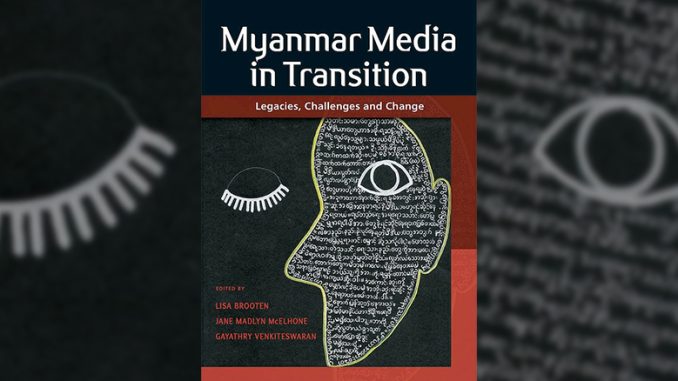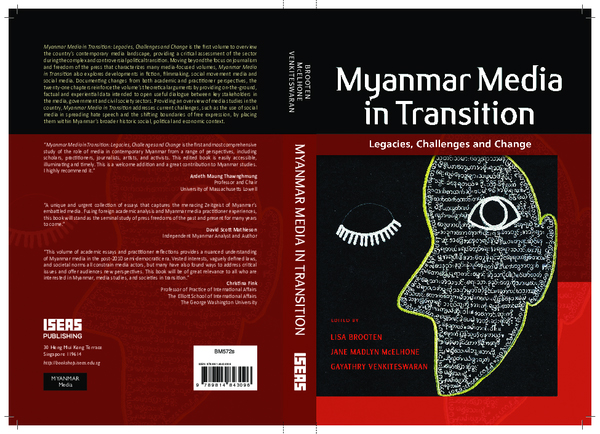
Title: Myanmar Media in Transition: Legacies, Challenges and Change
Edited by: Lisa Brooten, Jane Madlyn McElhone and Gayathry Venkiteswaran
ISEAS Yusof Ishak Institute, Singapore 2019.
Paperback: 394 pp (plus front and end material)
This rich collection of essays is both interesting and poignant. It contains a range of scholarly but accessible articles, and some additional interviews and reflections, on a dynamic and politically, socially and economically important sector during an extraordinary period in Myanmar’s recent history. The poignancy lies in how that transition (if that’s what it was) was destroyed by the armed forces, when they seized power on 1 February 2021 (using the utterly spurious pretext of irregularities in the November 2020 elections).
Following the Myanmar Army’s illegal seizure of power, the country has been plunged into chaos. In July 2022, half of Myanmar is under the authority of a range of ethnic armed organisations, and/or plunged into new armed conflicts with dozens of People’s Defence Forces (PDF), who are determined to resist the military takeover, at great cost to themselves and civilian communities. Many of the PDF fighters and others opposed to the military regime have come from the media, and in some cases remain engaged as activist journalists or otherwise working in the ICT sector.
At the time this edited volume was assembled, Myanmar’s prospects seemed different. As many of the authors point out, the country’s supposed transition was plagued by multiple difficulties. Not least, many of the essays record and explain the disappointment experienced by so many progressives in Myanmar in the period following April 2016 when Aung San Suu Kyi’s National League for Democracy (NLD) assumed elements of government power – although the military continued to control key sectors of politics and the economy, under the failed 2008 constitution. ‘The Lady’ never assumed the presidency, but the NLD ran much of the country’s domestic and some of its foreign policy for five years until the 2020 elections. Although some progress was made in these years, it was undermined by the NLD government’s lack of interest in a pursuing peace process which could address the aspirations and demands of ethnic nationality communities; by the 2017 Myanmar Army genocide against the Rohingya, for which Aung San Suu Kyi acted as an apologist at the International Criminal Court at The Hague; and by a surprising enthusiasm on the part of the NLD administration to use legislation from the military period, working hand-in-hand with the Myanmar Army to increase suppression of journalists and freedom of speech. In retrospect, the period from 2011-2016 under the transitional U Thein Sein regime may be viewed as more progressive. During this period, Myanmar media began to emerge from decades of strenuous state suppression (37-41, Introduction). As the editors write, “there were high expectations that the NLD and State Councillor Aung San Suu Kyi would prioritise and nourish free media and free expression … [which were soon replaced by] disappointment and anger of journalists and free expression advocates about these unmet expectations” (3).

These twenty chapters examine many aspects of this period. The editors’ Introduction provides an excellent orientation. Facebook makes an appearance on page 1, and through many of the chapters is rightly criticised for the social media behemoth’s baleful influence on political cultures in Myanmar. Other shameful cases recounted include the arrest in 2017 (under the NLD regime) and subsequent imprisonment of two Reuters journalists, Wa Lone and Kyaw Soe Oo, for reporting on a massacre of Rohingya.
The Introduction also provides a useful overview of recent Myanmar political history, and roles of the media. One of the many significant developments traced is the growth of telecommunications since 2011 (when only 1% of the population was online) to 2017 (when an estimated 95% of the population had access to mobile services: 31). During this period, Myanmar was considered the fastest growing smartphone society in the world.
The chapters are all well-argued and referenced, making them academically credible. Several include useful mini literature reviews. They cover private and state-run media.
It would be invidious to focus on many individual chapters, given the rich variety presented. Susan Banki and Ja Seng Ings’ account of the life and times of The Irrawaddy magazine (to which this reviewer contributes) frames the story in terms of precarity and risk, which are sadly relevant to today’s media context. The chapter is both informative and well written.
Jane Madlyn McElhone’s chapter on ethnic media is particularly useful in its focus on peace and conflict issues, and how these impact on and are framed by the media. She and Broten, two of the three editors, provide an informative account of donor technical and financial support to the development and empowerment of Myanmar media, which stands as an important historic overview of the shift from supporting exile/border-based media, to working ‘inside’ Myanmar (121) – a shift which is now in reverse, in response to the brutal crackdown on media under the present junta. They report that, “at nearly $53 million, Myanmar was the fifth largest media support recipient country between 2010 and 2015” (100). Like several others, this chapter also focuses on ethnic media, the development of which was an important phenomenon of the past two decades. The authors reflect on the different challenges and rewards of donor-funded and private sector media, which often overlap (e.g. pp 211-13).
Other chapters focus on issues popular music (Heather MacLachlan), film (Jane Ferguson, with a typically well-written and insightful chapter), the Human Rights Human Dignity Film Festival (Mon Mon Myat’s excellent chapter); interactions between the Union Election Commission and journalists (Carine Jacquet explains the perspectives of different stakeholders). Several authors cover the Rohingya situation in relation to media (e.g. Eaint Thiri Thu’s engaging chapter), including detailed explanations of how Facebook has “been used to spread rumours and hate speech, provoking violent reactions” (42). Yan Naung Oak and Brootens’ chapter further discusses “Facebook’s role in hate speech and the resultant waves of violence” (328), but goes beyond this to look at the roles of market liberalisation in the media. The discourse analysis presented here includes only one ethnic nationality subject, but is nevertheless fascinating in its analysis of shifts in narrative and memes among social media users and producers.
Kamran Emad and Erin McAuliffes’ chapter on privacy risks in Myanmar’s ICT sector is sadly particularly topical, in the present context. They note that “risks to human rights are amplified by the generally low levels of digital literacy among users” (142), and discuss the positioning of major telecoms companies such as Telenor (which this year sold its stake in Myanmar’s telecoms sector to junta-linked crony company). Htaike Htaike Aung and Wai Myo Htut provide an important chapter on telecommunications reform in Myanmar (before the coup), “From Blogging to Digital Rights” (366), which is rather depressing in its documentation of failure and suppression, including under the previous supposedly democratic government in Myanmar. Jennifer Leehey provides a case study of the suppression of local media (in Tanintharyi), and the brave struggles of Dawei and other local media actors. Ma Thida, a well-known Myanmar writer, provides a fascinating account of Myanmar’s literary history.
In many places, it is heartbreaking to read about the creativity and energy for change which existed during this period of hope and reform, before the disastrous 2021 coup. Of course, that energy and passion still exists in Myanmar – although the junta seeks to crush and marginalise independent voices.
This volume is the first of its kind in English, including both empirical and theoretical contributions, by academics and practitioners, foreigners and Myanmar people. It will be essential reading for anyone interested in Myanmar media, at least in the recent past. The struggle for free media, justice and democracy in Myanmar continues, in many cases through the ongoing work of those included in this important volume.
Reviewed by Ashley South
Ashley South is a Research Fellow at the Centre for Ethnic Studies and Development at Chiang Mai University
